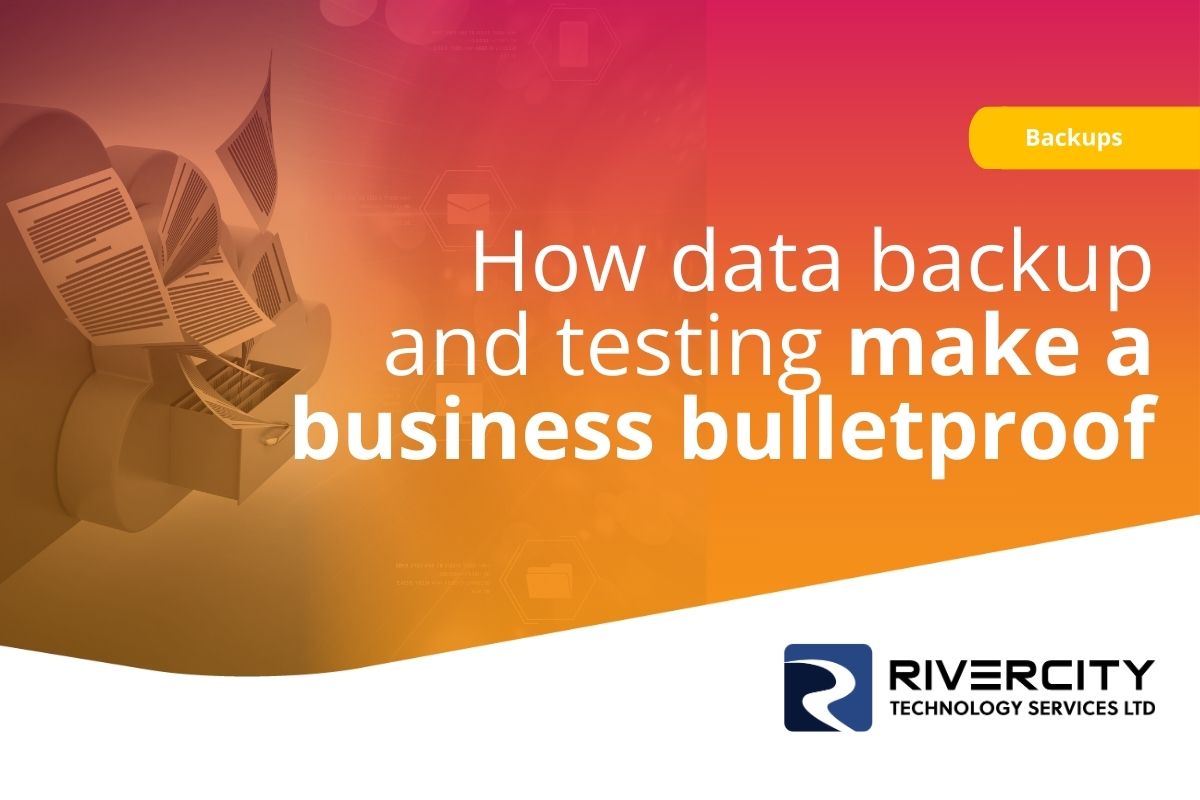Imagine this: You arrive at your office on a seemingly ordinary Monday morning, ready to tackle the week ahead. But as you power up your computer, you’re greeted not by the familiar hum of productivity, but by… nothing.
You check the power and start stabbing at buttons. And your heart sinks as you realize something’s happened to it… and the implications.
Months, perhaps even years, of invaluable business data – customer information, financial records, project files – all gone in the blink of an eye. Panic sets in as you scramble to salvage what you can, see what files you emailed to colleagues and try to remember what’s missing.
This scenario might sound like a nightmare, but for many businesses it’s a harsh reality. The loss of critical data can strike at any moment, wreaking havoc on operations and sending shockwaves through the entire company. The consequences reach far beyond inconvenience; they can cause significant downtime, financial loss, damaged reputation, and even legal issues.
Consider the ripple effect: Without access to essential files and systems, your employees are left unable to work.
Meanwhile, customers grow frustrated as services grind to a halt, eroding their trust and loyalty.
And let’s not forget the financial toll
- every minute of downtime equals potential revenue loss, not to mention the enormous costs associated with data recovery efforts.
But amidst the chaos and despair,
there’s a beacon of hope: Backups.
Safeguarding your business assets
is not just a recommendation, it’s an absolute necessity. By implementing robust backup strategies, you can shield your business from the devastating consequences of data loss, maintaining continuity, resilience, and peace of mind.
When it comes to data, it’s not a matter of if disaster strikes, but when, and the best defense is a proactive offense.
What exactly is data backup, and how does it work?
In simple terms, data backup is a safety net for your business’s most precious asset: Its information. It’s the process of making a copy of your important files, documents, and data, and storing that copy in a secure location separate from your primary system.
magine your business’s data as a collection of valuable treasures kept in a vault. Now,
imagine that vault has a backup vault located in a different, equally secure location. That backup vault holds duplicate copies of all your treasures, ensuring that even if something happens to the original vault – be it a burglary, a fire, or a flood – you can still access and retrieve your treasures from the backup vault.
But how does this process work digitally?
The first step is to identify which data is critical for your business operations. This might include customer information, financial records, intellectual property, employee files, and anything else essential to your day-to-day functions.
There are various methods for backing up data, each with its own pros and cons. These include:
Full backups: Making exact copies of all your data at once.
Incremental backups: Only backing up the data that has changed since the last backup, reducing storage space and time.
Cloud backups: Storing your data securely on remote servers accessed via the internet.
On-site backups: Keeping backups locally, such as on external hard drives or tape drives (yes these are still used today).
Hybrid backups: Combining on-site and cloud backups for added redundancy.
Once you’ve chosen your backup method(s), it’s time to implement them. This might involve installing backup software, configuring automatic backup schedules, and setting up encryption to protect your data during transit and storage.
Where you store your backups is crucial. They should be kept in a secure location, preferably off-site and away from your primary business premises. This protects them from physical threats like theft, fire, and natural disasters. Storing copies in two off-site locations on different sides of the country is even more secure.
By creating and implementing a strong data backup strategy, you’re not just protecting your business against potential disasters; you’re also safeguarding its future.
Why is data backup so important?
The importance of data backup can’t be overstated. Whatever the size of your business, data loss can have huge consequences. Let’s take a closer look at why having backups is essential:
Protection against data loss Data loss can occur for a multitude of reasons, including hardware failures, software glitches, human error, cyber attacks, and natural disasters. Without backups, recovering lost data can be a Herculean task – if not impossible. Backups act as a safety net, ensuring that even if the worst-case scenario unfolds, your business can bounce back with minimal disruption.
Maintaining business continuity Downtime is the enemy of productivity and profitability. When critical data is lost, it can bring your business to a grinding halt, causing delays in operations, missed deadlines, and frustrated customers. With backups in place, you can quickly restore essential data and resume normal business operations, minimizing downtime and its associated costs.
Preserving reputation and trust A single data breach or loss can damage your business’s reputation and your customer trust. Whether it’s sensitive customer information or intellectual property, failing to protect data can have far reaching consequences. By demonstrating your commitment to data security through robust backup practices, you not only protect your business but also reassure customers and stakeholders that their information is safe in your hands.
Compliance and legal obligations Depending on your industry and location, you may be subject to various data protection regulations and legal requirements. Failure to comply with these can result in hefty fines, legal liabilities, and damage to your brand. Implementing data backup solutions that adhere to industry standards can help ensure compliance and mitigate the risk of legal issues.
Facilitating growth and innovation Having access to reliable data allows you to make informed decisions and drive business success. Whether that’s analyzing customer trends, refining business processes, or developing new products and services, you’ll always have the right data to hand.
Data backup isn’t just best practice, it’s critical to modern business resilience and success. By prioritizing data backup and testing, you’re not only protecting your business’s present but also safeguarding its future.
But that’s not all…
Now you’ve set up your data backup system you can pat yourself on the back – it’s a job well done, right?
Well, not quite.
While having backups is a crucial first step, it’s only half the battle. The other half? Regularly testing those backups to ensure they’re doing what they’re supposed to do.
Imagine this scenario: A catastrophic event occurs, and you rush to restore your data from backups, only to discover that they’re corrupted or malfunctioning.
Cue panic mode.
Regular backup testing helps you uncover any issues or weaknesses in your backup system before disaster strikes, giving you the opportunity to address them proactively.
Not all backups are created equal. Sometimes, files may fail to back up properly, or crucial data may be inadvertently excluded from the backup process. By testing your backups regularly, you can verify the integrity and completeness of your data, making sure that everything you need is safely stored and accessible when you need it most.
And there are a few different methods for testing backups:
File restoration test This involves randomly selecting files from your backups and attempting to restore them to their original location. This helps verify that individual files can be recovered successfully from the backup.
System recovery test In this test, you simulate a complete system failure and attempt to restore your entire system from backup. This comprehensive test verifies that your backup system can successfully recover your entire infrastructure in the event of a catastrophic failure.
Validation checks Regularly perform validation checks on your backup data to ensure its integrity and completeness. This might involve using something called checksums or hash values (which verify that data is complete and hasn’t been tampered with) to check the integrity of backup files.
Automated testing tools Consider using specialized software or tools designed for backup testing. These can automate the testing process, making it easier and more efficient to regularly verify the reliability of your backups.
So far so good, right? Now you need a plan for carrying out the tests...
Establish a testing schedule Set up a regular schedule for testing your backups, whether it’s weekly, monthly, or quarterly. Consistency is key to ensuring that your backup testing remains a priority.
Document testing procedure Document step-by-step procedures for testing your backups, including who is responsible for performing the tests, what tests will be conducted, and how the results will be documented and analyzed.
Allocate resources Allocate the necessary resources, including time, personnel, and tools, to conduct thorough backup testing. Treat backup testing as an essential part of your business continuity strategy and allocate resources accordingly.
Review and analyze results After conducting backup tests, review and analyze the results to identify any issues or areas for improvement. Use this feedback to refine your backup procedures and mitigate any potential risks or vulnerabilities.
How do you measure up?
When it comes to backup and recovery testing, it’s not just about having working backups in place - it’s about ensuring that you can recover your data and systems within acceptable timeframes and with minimal data loss.
This is where Recovery Time Objective (RTO) and Recovery Point Objective (RPO) come into play. These are important – and here’s why
Your RTO represents the maximum tolerable downtime for your data and systems. In other words, it’s the amount of time your business can afford to be without access to critical resources before it starts experiencing significant negative impacts. By measuring and optimizing your RTO, you can minimize downtime and ensure that your business can resume normal operations as quickly as possible following a data loss incident.
On the other hand, your RPO indicates the maximum acceptable data loss during a disaster. It represents the point in time to which you can recover your data without experiencing unacceptable losses. By measuring and optimizing your RPO, you can minimize data loss and ensure that your business can recover essential information with minimal disruption.
The specific values of your RTO and RPO depend on what’s important to your business. Things like how crucial your data and systems are, the impact of downtime and data loss on your operations and reputation, and any rules or regulations you need to follow all play a role in setting these objectives.
When you’ve figured out your RTO and RPO goals, it’s time to put your backup and recovery plans to the test. This means pretending different kinds of disasters happen and seeing if you can get things back up and running within the timeframes you’ve set and without losing too much data. Doing these tests regularly helps you spot any problems and fix them before a real emergency hits.
And don’t forget to keep improving! Technology changes, and so do your business needs. It’s a good idea to keep checking your backup and recovery plans, making updates as needed. This might mean trying out new tools, updating how you do things, or moving resources around to deal with new risks.
Can we do this for you, so you don’t have to think about it?
We’ve covered a lot of ground, and it might seem a little overwhelming. But it doesn’t have to add more stress to your load. Help is always at hand.
Whether you’re looking to implement a new backup system, optimize your existing procedures, or conduct thorough testing to ensure your readiness for emergencies, we can help.






















